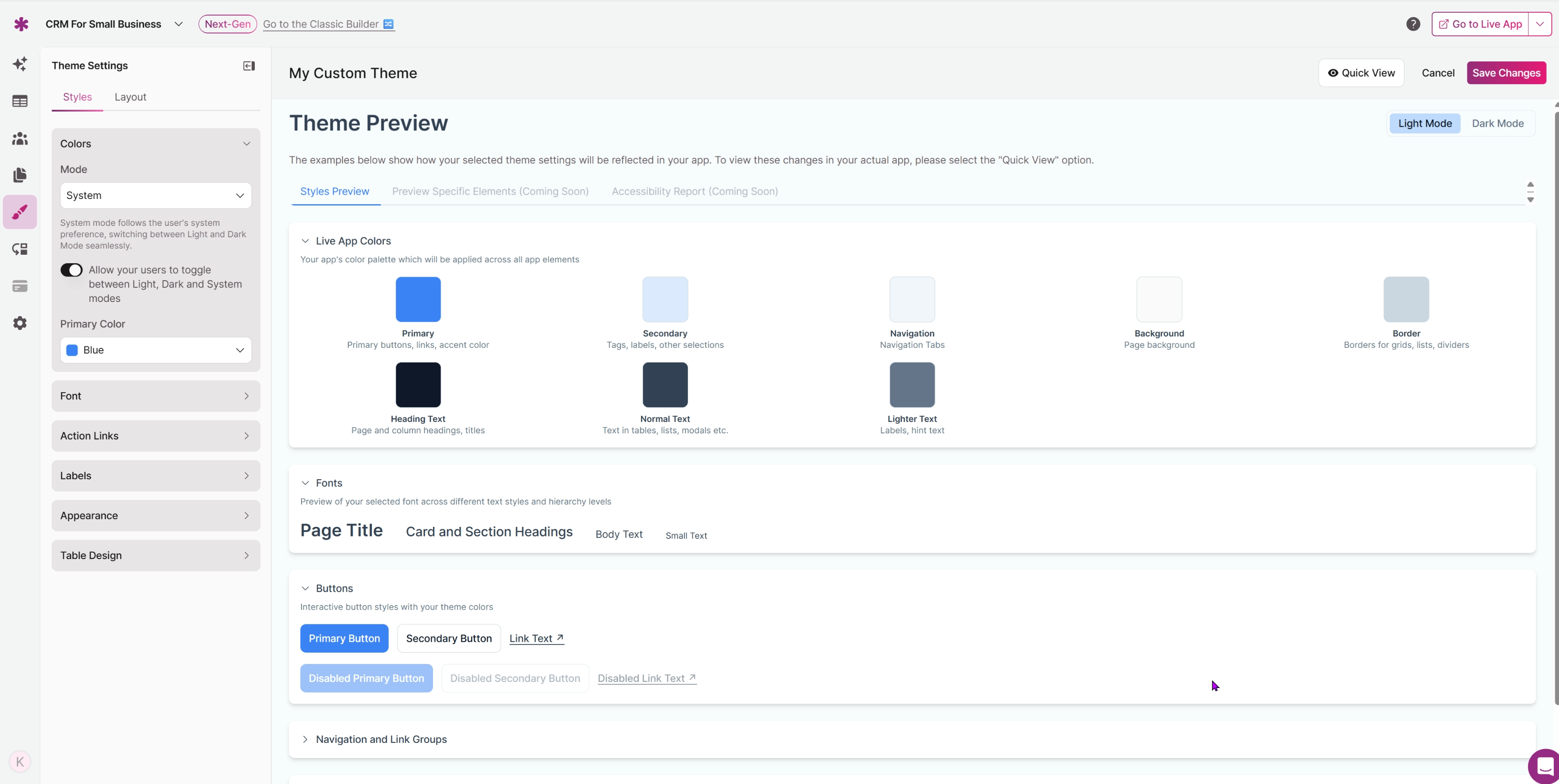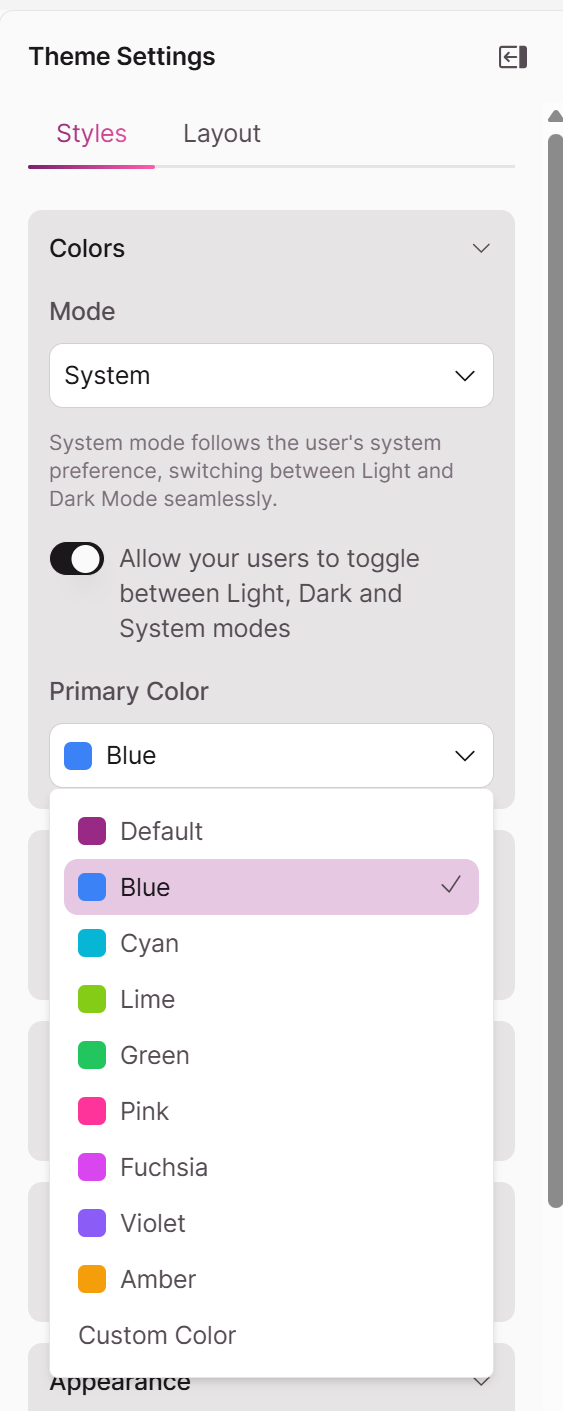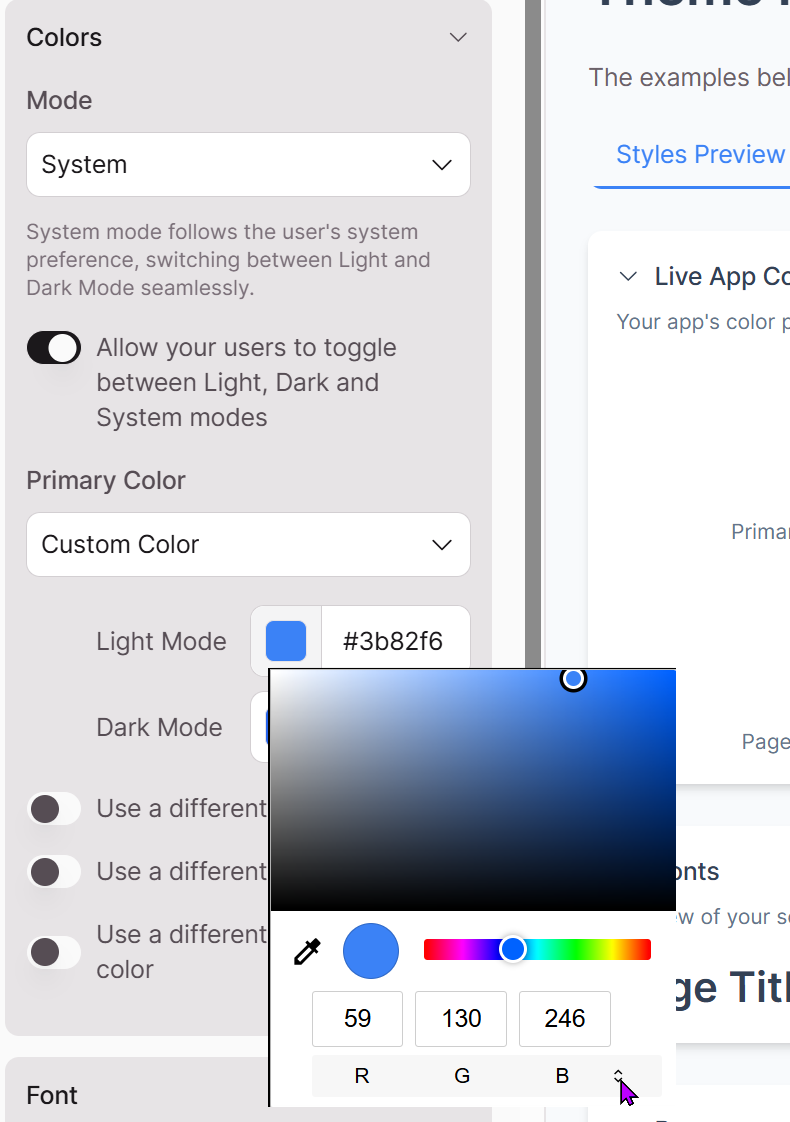Themes: Complete Styles Guide
Transform your app's visual identity with intelligent color systems that automatically generate professional themes from a single color choice.
What you'll learn:
- How to customize your app's complete visual theme
- Using the intelligent color system for professional results
- Setting up light and dark mode options
- Advanced customization techniques and best practices
Understanding Themes
Themes makes it easy to customize your app by automatically generating complete, harmonious color palettes from your primary color selection. This intelligent system eliminates guesswork while ensuring professional design consistency.
When you select a primary color, the system calculates complementary colors, appropriate contrast ratios, and harmonious variations that work seamlessly together. You get a polished, professional appearance without extensive design expertise or hours of fine-tuning individual colors.
Key Features
- Intelligent color generation: Complete palettes from one color choice
- Light and dark modes: User-selectable viewing preferences
- Real-time preview: Instant visual feedback with Quick View
- Brand flexibility: Override specific colors while maintaining harmony
Tip: Use the Quick View feature to see exactly how your theme changes appear in your live application as you make adjustments.
Getting Started
Accessing Theme Settings
- Open your Knack Builder
- Click Themes in the left navigation menu
- Select My Custom Theme to open Theme Settings
- You'll see two main sections:
- Styles: Color customizations and typography
- Layout: Navigation positioning and structural elements
The interface organizes options logically, so you can focus on specific customization aspects without feeling overwhelmed.
Theme Styles Tab

The Theme Styles interface is divided into two main areas:
- Left Navigation Panel - Configuration options and settings
- Main Content Area - Theme Preview and real-time visual feedback
Colors Section
Mode
- System
- Light Mode Only
- Dark Mode Only
When "System" is selected in the Mode dropdown:
- App automatically follows the Live App user's device settings
- Switches between Light and Dark modes based on system preferences
User Toggle Option
When "System" is selected, you have an addition option to enable:
"Allow your users to toggle between Light, Dark and System modes". When enabled,
- Users see mode selection controls in your live app
- They can manually choose their preferred viewing mode
- Options include Light, Dark, and System modes
- Settings are remembered for each user
Mode Preview
Use the Light Mode/Dark Mode toggle buttons at the top of the preview to:
- See how your color choices work in both modes
- Verify text readability in light and dark themes
- Ensure your brand colors work effectively in both contexts

Setting Your Primary Color
Your primary color serves as the foundation for your entire theme. This color influences all other generated colors. When Mode is set to System, you'll be able to set up primary colors for light mode and dark mode.
Selection Methods:
- Color Picker: Choose from curated common colors for quick selection
- Custom Picker: Access the full spectrum with:
- Visual color selection or:
- RGB, HSL, or Hex input
- Visual color selection or:


Advanced Color Options
While the intelligent system works well for many applications, you can override specific colors for brand requirements when you choose a custom color:
- Secondary Primary Color: Customize the secondary color
- Navigation Background: Customize the navigation menu background color
- Page Background: Set a specific background color for pages. You'll find options to use one color or to create a custom gradient with two colors.
When using gradients:
- Opt for angles between 120° and 165° for a natural flow
- Avoid straight vertical (90°) or horizontal (0°) gradients
- Consider 135° as a safe default angle
- Ensure text remains readable across the entire gradient
Font Section
Expand the Font section in the left panel to access:
- Font Family Selection - Choose from provided fonts or upload custom fonts.
Learn how to upload custom fonts here!
Action Links Section
Coming Soon!Customize styling options for clickable text elements
Labels Section
Coming Soon!Customize field label styling and appearance options
Appearance Section
Expand to set general visual styling options:
- Rounded or sharp corners for buttons and cards
- Shadows for cards
Table Design Section
Data table customization options include:
Borders
- Rows only: Shows horizontal borders between table rows
- Rows and columns: Shows both horizontal and vertical borders creating a full grid
Max Height
Enables/disables maximum height constraints for tables. When enabled, tables will have scrollable content if they exceed the maximum height.
Row Spacing
- Compact: Minimal padding for dense data display
- Default: Standard spacing for balanced readability
- Comfortable: Extra padding for improved readability and touch interaction
Visual Enhancements
- Alternate row background colors: Creates zebra striping for easier row scanning
- Hover on a row highlights it: Provides visual feedback when users hover over table rows
Theme Preview Area
Header Section

In the top header section, you'll find your theme name, along with:
- Quick View - Launch a live preview of your application
- Cancel - Discard unsaved changes
- Save Changes - Save your changes, or Save and Apply your changes to the Live App.
Save Process
- Make your desired changes in the left panel settings
- Review changes in the Theme Preview area
- Test using Quick View if needed
- Click Save Changes
- Select Save Changes to save your progress
- Select Save and Make Active to save your progress and apply them immediately to your Live App
Cancel Changes
- Click Cancel to discard all unsaved modifications
- This returns all settings to their last saved state
- Any unsaved work will be lost
How to Use Quick View
- Click Quick View button in the top-right area
- Your app opens in a new window/tab with current theme applied
- Navigate through different pages to test your theme
- Return to Theme Settings to make adjustments
- Click Stop Quick View to end the preview session
What to Test in Quick View
- Text readability across all content types
- Button and link visibility and contrast
- Navigation element clarity and usability
- Form field appearance and usability
- Table and list readability
- Overall visual hierarchy and balance
💡Test major changes in Quick View before saving
💡 Save changes incrementally as you work
Theme Preview Panel
The examples in this area show how your selected theme settings will be reflected in your app. To view these changes in your actual app, please select the 'Quick View' option.
Preview Mode Toggles:
Use the Light Mode/Dark Mode toggle buttons at the top of the preview to:
- See how your color choices work in both modes
- Verify text readability in light and dark themes
- Ensure your brand colors work effectively in both contexts
Styles Preview
There are different expandable sections to show how theme configurations are applied across your app
Live App Colors Section
A display of your complete color palette showing how colors are applied:
- Primary: Primary buttons, links, accent color
- Secondary: Tags, labels, other selections
- Navigation: Navigation Menu background
- Background: Page background
- Border: Borders for grids, lists, dividers
- Heading Text: Page and column headings, titles
- Normal Text: Text in tables, lists, modals etc.
- Lighter Text: Labels, hint text
Fonts Section
Preview of your selected font across different text styles and hierarchy levels
Typography Hierarchy Display:
- Page Title - Large, bold text sample
- Card and Section Headings - Medium, semi-bold text sample
- Body Text - Regular weight text sample
- Small Text - Smaller, regular weight text sample
Buttons Section
Interactive button styles with your theme colors
- Interactive button styles: Shows how theme colors are applied to different button states
- Multiple button variations: Displays primary, secondary, and other button styles
- Real-time color application: Buttons update automatically when theme colors change
Navigation and Link Groups Section
Main navigation menu and link group styling
- Selected and unselected navigation menu items and hover states
- Selected, unselected, and inactive Link Group tabs
Action Links
Shows how the different view, edit and delete links which are used across various elements
Cards Appearance
Displays a card with the appearance configurations selected
Table Design
An example grid with the theme colors and grid settings applied
Understanding Knack's Intelligent Color System
How It Works
The intelligent color system uses established color theory principles to generate complete, harmonious palettes from your primary color selection. When you select a primary color using the dropdown in the left panel, the system automatically:
- Creates complementary colors using color harmony calculations
- Ensures professional consistency across all elements
- Balances visual appeal with practical usability
- Updates all color swatches in real-time in the preview
Color Functions Explained
Each generated color serves specific interface functions as shown in the Live App Colors section:
Primary Color
- Used for primary buttons, important links, and accent colors
- The dominant color that reinforces your brand identity
- Appears prominently in call-to-action elements
Secondary Color
- Applied to the active page in the navigation menu and filter tabs
- Supporting elements that complement your primary color
- Used for less prominent interactive elements
Navigation Color
- Background color for the main navigation tabs and menus
- Provides wayfinding structure throughout your app
- Ensures navigation elements are clearly distinguished
Background Color
- Main page background color
- Foundation element that provides visual structure
- Affects overall app brightness and contrast
Border Color
- Applied to borders for grids, lists, and dividers
- Creates subtle boundaries that organize content clearly
- Helps separate different content areas
Text Colors
- Heading Text - Page and column headings, titles (darkest for maximum readability)
- Normal Text - Text in tables, lists, modals, and main content (medium contrast)
- Lighter Text - Labels and hint text (lighter for secondary information)
Each text color is automatically calculated for optimal readability against its intended background while maintaining clear content hierarchy
Color Psychology Considerations
Blue - Conveys trust and professionalism (popular for business applications)
Green - Suggests growth, success, and environmental consciousness
Red - Indicates urgency or importance (use carefully to avoid creating anxiety)
Purple - Implies creativity and innovation
Orange - Energetic and friendly, good for engaging applications
Gray - Professional and neutral, works well for business tools
Testing Your Theme
Use this handy checklist:
Visual Testing:
- Navigate through all major app sections using Quick View
- Verify text readability in all contexts (forms, tables, navigation)
- Check button visibility and contrast
- Test both Light and Dark modes if user toggle is enabled
- Ensure visual hierarchy is clear and logical
User Experience Testing:
- Get feedback from colleagues or beta users
- Test on different devices and screen sizes
Brand Consistency:
- Ensure theme aligns with your brand guidelines
- Verify logo and brand elements work with new colors
- Test brand recognition with your color choices
Coming Soon Features
The Next-Gen Themes system continues evolving with new capabilities:
Preview Specific Elements Tab
- Targeted preview for particular interface components
- Detailed view of how themes affect specific page elements
Accessibility Report Tab
- WCAG contrast validation and compliance checking
- Suggestions for improving accessibility
- Action Links Styling - Control over clickable text elements
- Labels Customization - Field label appearance and formatting options
These upcoming features reflect our commitment to making theme customization both powerful and accessible for all users
Updated 3 months ago
